by L. H. Greene and J. E. Klett* (1/20)
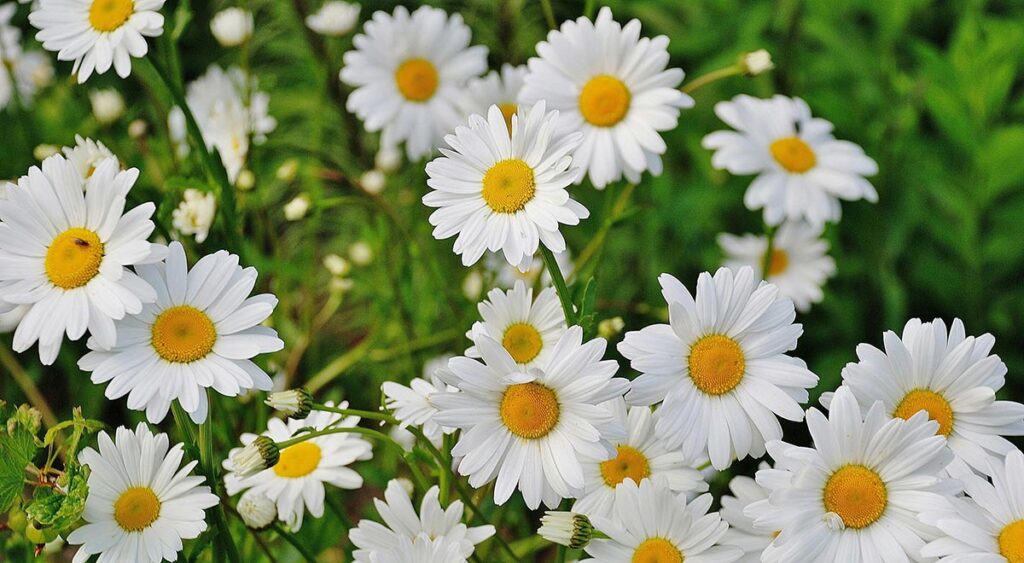
Quick Facts…
- Choose your garden location before designing it.
- Consider sun exposure, wind, soil type and irrigation.
- Plan the garden to scale on paper.
- Consider the amount of time needed to maintain the garden.
- Prepare a list of desired perennials.
- Choose perennials that match the site selection.
- Group perennials according to water need.
- Add organic matter to the garden to improve soil aeration and drainage.
A well-designed perennial garden can provide many years of beauty and enjoyment. Careful selection of plant material and thoughtful planning will result in a full season of color.
Perennials often require less maintenance than most annual flowers. Once established, they generally require less water and have fewer pest problems than annuals.
Perennial gardens may serve as a border along a fence or property line, easing the maintenance and water requirements of a lawn in such areas. It is visually pleasing to locate a garden against a background such as a fence, wall, or shrubs.
Site Selection
Site selection is the first step in planning a successful perennial garden. Take stock of your environmental conditions to determine an optimal site. Ease of access, proximity to outdoor living areas, and visibility from within the home are all factors to be considered. A perennial garden may be the focal feature in the landscape. Locate the perennial garden so it can be accessed from at least two sides. When space is available, beds that are 6′ wide or wider look most pleasing. Many perennials require abundant sunshine – 8 hours or more during the longest days of summer. Shade-loving perennials such as ferns, bleeding heart and hostas are best suited to locations with less sunlight, like the north side of a home, or in filtered shade.
Good air circulation is important to avoid disease. Still, warm, humid air creates ideal conditions for powdery mildew to develop. See fact sheet 2.902, Powdery Mildews, for more information. To minimize disease problems, give perennials adequate growth space when planting. Design your garden with the mature size of the plants in mind.
Designing Perennial Gardens
Determine garden size by considering your available space and the amount of time you have for maintenance. Perennial gardens should be functional, simple to maintain, and provide a progression of bloom and textures all season. Stepping stones can allow easy access through larger garden spaces and prevent soil compaction.
To begin your design, measure the proposed site. On graph paper, sketch the layout to scale, using a scale of 1 inch = 4 feet. Then proceed with the following steps: Locate existing structures – walls, fences, walks, etc. Locate existing plants, such as trees and shrubs. Consider their mature size. Sketch the desired outline of the bed. It can be helpful to place a garden hose around the area to visualize the shape. Measure lines from a known reference point, such as the side of the house or patio and put it on the graph paper.
After deciding on the outline of the garden, add plants by following
these design principles:
- Place plants of the same variety in groups of three, five or seven to increase the impact of color or texture.
- Repeat groups of the same plant two or three times in the space to create continuity and harmony.
- Use taller plants at the back of the bed, or in the middle of a bed viewed from multiple sides.
- In urban communities, consider view lines and potential safety obstructions in the case of streetscape and other front-of-lot gardens.
- Place shorter plants toward the front of the bed.
- Bring select taller plants forward to increase variation in height.
- Combine plants with various forms, texture, and color.
- Consider foliage size, shape and texture in addition to bloom time and color.
- Place plants on the plan with diagonal or triangular spacing.
- Plan for the mature size of plants and leave adequate room for growth.
- Consider adding spaces of void within the plan.
- Add annuals and bulbs for accent color.
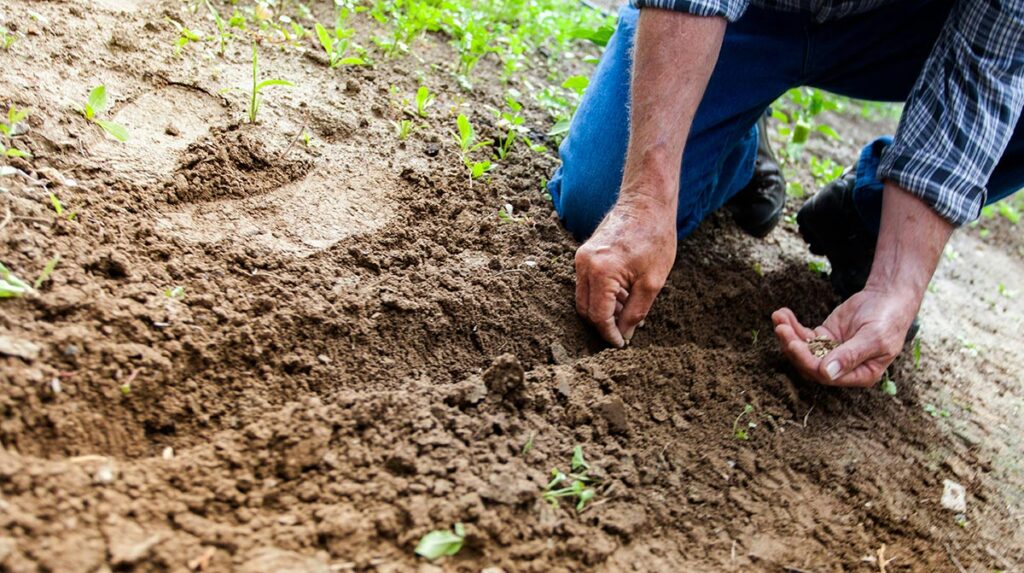
Site and Soil Preparation
A beautiful healthy perennial garden requires soil that provides good drainage. Measure the fertility and tilth of the soil in your proposed garden by doing a soil test. See Fact Sheet 0.501, Soil, Water and Plant Testing, for more information.
Prepare the site by removing any existing grass or plant material in the designated area. Install edging to prevent encroachment of turf grass. Incorporate organic matter (compost, sphagnum peat, or wellaged manure) 12 inches deep. A general recommendation is 3 cubic yards of organic matter for every 1,000 square feet. This is the equivalent of a 1-inch layer over 1,000 square feet. See fact sheet 7.235, Choosing a Soil Amendment,
for more information.
Plant Selection
The list of possible perennial plants and design combinations is endless. See Fact Sheet 7.405, Herbaceous Perennials, for a listing of readily available species. Many new improved varieties are introduced annually that are adapted to our climate.
Choose plants for light and water requirements, bloom period, form, leaf texture, flower color, and height and width requirements. Bloom times may vary with weather, soil conditions and elevation. At higher elevations, bloom times are later. See fact sheet 7.406, Flowers for Mountain Communities, for more information on gardening at altitude.
Tall perennials, such as delphinium, foxglove and hollyhock may require staking in windy sites. In windy areas or where stakes are undesirable, dwarf varieties may be chosen.
The most important consideration in selecting plants for a perennial garden is to group them according to their environmental and cultural requirements. Place plants with like water needs together in the garden and plan to irrigate accordingly. For example, place drought-tolerant plants together at the top of a slope and moisture-loving plants in a swale or low spot where runoff collects. This is called hydrozoning.
When selecting plants, plan for maintenance considerations like pruning, fertilizing, deadheading, division, invasiveness, and pest and
disease resistance.
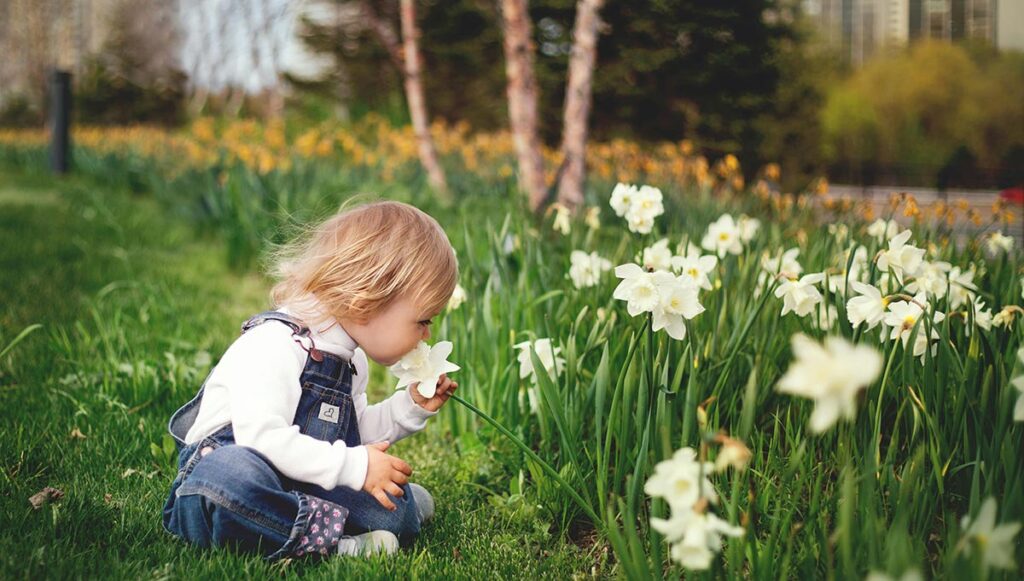
Culture and Maintenance
Watering frequency varies with sun and wind exposure, temperature, soil type and individual plant needs. Drooping leaves or stems and blossom drogp are signs that irrigation needs to be increased. New plantings in full sun often need water every couple of days during the first month after planting, depending on weather conditions. After the first month, progress to longer intervals between watering (four to six days) to encourage roots to expand into surrounding soil. Mulched plants will not dry out as quickly.
The water needs of a perennial garden are different from turf so plant to water them separately. Drip irrigation systems can be utilized, and are effective in perennial gardens. Please see Fact Sheet 7.239, Operating and Maintaining a Home Irrigation System, for more information.
Maintenance
Maintenance of a perennial garden during the growing season consists of weeding, deadheading, and pest control. Early spring and fall maintenance consists of trimming and removing old leaves and cutting stems back to the basal foliage. In order to support winter pollinator and wildlife habitat, less
perennial cutback and clean-up is suggested during the fall season. The exception to this rule is in the case of the presence of known pest or disease, like powdery mildew. If disease exists in the perennial garden, a thorough fall clean-up is warranted.
Plant Division
After three to five growing seasons, division of some perennials may be necessary. Overcrowded perennials bloom poorly. In general, divide plants when they are not blooming. Spring and summer-blooming perennials such as creeping phlox or coreopsis are usually divided in the fall. Plants that flower in mid-to late summer or fall such as dalily or yarrow should be divided in the spring before growth begins.
To divide plants use a spade, shovel or fork to dig around and under the entire plant to lift the rootball out of the soil. Remove soil from the roots by hand or by washing with a hose. Using pruning shears or a sharp knife, cut apart the healthiest parts of the plant. Remove any dead, discolored or decayed parts of the plant. Divide the clump into four or five new clumps. Replant these divisions as soon as possible. Protect with mulch, and water as needed through the fall and winter.
Mulch and Winter Water
Mulching is one way to reduce weed growth and conserve water. Many mulches are available including organic and inorganic options. For more information on mulches please see Fact Sheet 7.214, Mulches for Home Grounds. Winter watering is very important depending on your specific weather conditions. Colorado winters typically have dry air and low soil moisture conditions especially between November (when irrigation systems are turned off) and February, when usual snow begins. Dry conditions can damage plants, especially any new plantings which do not have significant root systems upon which to draw.
Water only when temperatures are above freezing during the early part of the day. Some perennials prefer well-drained dryer soils in winter. See Fact Sheet 7.211, Fall and Winter Watering, for more information.
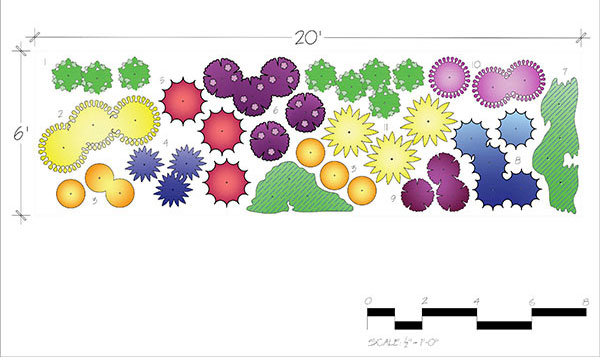
Planting Plan #1 (suitable for sunny streetside)
|
Table for Planting Plan #1 (suitable for sunny streetside) | ||||
|---|---|---|---|---|
| # | Botanical name | Common name | Qty | |
 | 1 | Heuchera sanguinea ‘Snow Angel’ | Snow Angel coral bells | 8 |
 | 2 | Solidago canadensis ‘Golden Baby’ | Golden Baby goldenrod | 3 |
 | 3 | Gaillardia x grandiflora ‘Goblin’ | Goblin blanket flower | 6 |
 | 4 | Agastache rupestris | Sunset hyssop | 3 |
 | 5 | Iris hybrids | Iris | 3 |
 | 6 | Echinacea purpurea | Purple coneflower | 5 |
 | 7 | Artemisia schmidtiana | Silver mound sage | 7 |
 | 8 | Salvia nemorosa ‘Caradonna’ | Caradonna salvia | 5 |
 | 9 | Penstemon ‘Husker Red’ | Husker Red penstemon | 3 |
 | 10 | Sedum spectabile | Autumn Joy sedum | 3 |
 | 11 | Hemerocallis species ‘Hyperion’ | Hyperion daylily | 3 |
|
Table for Planting Plan #2 (suitable for sunny corner) | ||||
|---|---|---|---|---|
| # | Botanical name | Common name | Qty | |
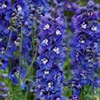 | 1 | Delphinium elatum | Delphinium | 6 |
 | 2 | Paeonia hybrids | Peony | 3 |
 | 3 | Rudbeckia fulgida ‘Goldsturm’ | Goldsturm black-eyed Susan | 6 |
 | 4 | Leucanthemum x superbum ‘Alaska’ | Alaska Shasta daisy | 5 |
 | 5 | Aster novae-angliae ‘Purple Dome’ | Purple Dome aster | 3 |
 | 6 | Asclepias tuberosa | Butterfly weed | 3 |
 | 7 | Geranium sanguineum | Bloody cranesbill | 10 |
 | 8 | Aquilegia caerulea | Rocky Mountain columbine | 6 |
 | 9 | Iberis sempervirens | Candytuft | 5 |
 | 10 | Oenothera macrocarpa | Silver Blade evening primrose | 5 |

Planting Plan #2 (suitable for sunny corner)
From Plannning to Planting
After developing a plan, consider careful plant selection at the nursery. Perennials grown in containers may be planted any time during the growing season. Plant them so they can become established before dormancy and the onset of winter. In Colorado, bare root perennials, often obtained from mail order nurseries are best planted in the spring.
Inspect plants prior to purchase. Look for plants whose new roots are fleshy and creamy white, not discolored or root bound. Store plants prior to planting in a cool, shady area. Remove the container before planting. If the soil ball includes masses of roots around the outer edge, carefully separate roots, or make several shallow cuts (1/2 inch or less) in several places along the outside of the rootball to encourage new roots to grow into the surrounding soil. Remove plants from containers just before planting in order to minimize root drying. Place plants at the same soil level as they were in the container. Avoid planting perennials too deeply, because plant roots can suffocate without sufficient available oxygen. After placing plants at the correct height, backfill the hole with soil. Water well, and watch for any settling. Adjust plant height as needed.
L. Greene, M. Kirk, and E. Smith collaborated on planting designs.
*L. H. Greene, Colorado State University graduate student, J. E. Klett, Extension Landscape Horticulture Specialist and Professor. *Original manuscript written by D. Waltman, former Colorado State University graduate student , and R. A. Cox, former Extension Horticulture Agent, Arapahoe County. 6/00. Revised 1/20.
Colorado State University, U.S. Department of Agriculture and Colorado counties cooperating.CSU Extension programs are available to all without discrimination. No endorsement of products mentioned is intended nor is criticism implied of products not mentioned.
Go to top of this page.





